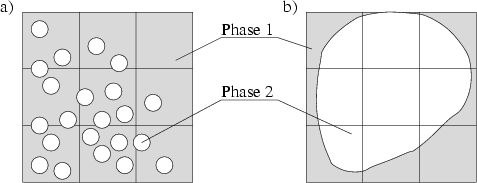Volume Of Fluid (VOF) Multiphase
The Volume Of Fluid (VOF) Multiphase model is a simple multiphase model. It is suited to simulating flows of several immiscible fluids on numerical grids capable of resolving the interface between the phases of the mixture.
The VOF Multiphase model is used to solve problems involving immiscible fluid mixtures, free surfaces, and phase contact time. In such cases, there is no need for extra modeling of inter-phase interaction, and the model assumption that all phases share velocity, pressure, and temperature fields becomes a discretization error.
The figure below provides an illustration of unsuitable grids (left) and suitable grid (right) for two-phase flows using the VOF model.

Due to its numerical efficiency, the model is suited for simulations of flows where each phase constitutes a large structure, with a relatively small total contact area between phases. A good example of this type of flow is sloshing flow in a water tank, where the free surface always remains smooth. If the tank movement becomes pronounced, this results in breaking waves, large numbers of air bubbles in the water, and water droplets in the air. The method would then require a fine mesh (at least three cells across each droplet/bubble) to produce small modeling errors.
The spatial distribution of each phase at a given time is defined in terms of a variable that is called the volume fraction. A method of calculating such distributions is to solve a transport equation for the phase volume fraction (see Volume of Fluid Method). The method uses the Simcenter STAR-CCM+ Segregated Flow model.
In order to obtain sharp interfaces between the phases, use the 2nd-order discretization scheme and set the appropriate value of the Sharpening Factor parameter. For more information, see High-Resolution Interface Capturing (HRIC).
When explicit or implicit multi-stepping is activated, the Segregated VOF solver performs multiple steps per time step. These options apply temporal sub-cycling to the transport of volume fraction and can improve the resolution of the interface between two phases. By default, the VOF free surface calculation is performed on the same time step as the other calculations. To ensure sharp resolution of the free surfaces, the CFL number is limited to 1. However, this limitation is overly restrictive, as other physics calculations can run at a much larger CFL number. This limitation reduces the computational efficiency of VOF free surface simulations. The multi-stepping feature removes this limitation on the CFL number. When sub-cycling is used for the free surface calculation, a larger time-step can be used for other calculations.
Thermal effects can also be included with the Segregated Multi-Phase Temperature model.
The VOF Multiphase model can be used to model change of state. Melting of ice and boiling of water are everyday examples of transitions between solid, liquid, and gaseous states of matter. Simcenter STAR-CCM+ provides models to describe boiling, cavitation, and melting and solidification.